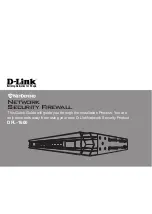
The Classification of Networks
2-5
Overview of Networking
Bus
The bus topology uses a single common cable or link (coaxial cable, broadcast
radio frequency) to connect the stations of the network to one another. The bus
topology is strictly an Ethernet phenomenon, and is frequently encountered in
existing Ethernet environments. Stations connect to the common media through a
series of taps, located a specified distance from one another along the common
cable, and only one station may successfully transmit onto the common media at
any one time. Bus topologies are noted for their simplicity, but are notoriously
difficult to troubleshoot. In addition, a failure of the bus media itself, due to
disruption or poor configuration, causes the network to cease functioning.
Tree
The tree topology arranges links and stations into distinct hierarchies in order to
allow greater control and troubleshooting. In order to function well, networks
using tree topologies must incorporate some form of “traffic control,”
determining when traffic is allowed to travel up and down the branches of the
tree. Similar to a well-defined chain of command, the tree topology shields
disparate network groups from affecting each other.
The tree topology also facilitates much more straightforward troubleshooting
procedures. The main downfall of the tree topology is its own organization. If
there is a failure on one of the branches of the tree, every branch that forks from
that point of failure becomes unable to communicate with the rest of the network.
Ring
The ring topology connects every station on the network to every other station in
the network in a contiguous circle. Most common in the Token Ring and FDDI
network technologies (discussed later), ring topologies rely on well-defined rules
of transmission and reception in order to function. Stations are connected in a
definite series, with information going from one station to the next in a
pre-defined order. Since each station is expecting transmissions from the station
before it and sending transmissions only to the station following it, ring
topologies can be made to incorporate automatic fault location and recovery
procedures.
Summary of Contents for MMAC-5FNB
Page 1: ...Cabletron Systems Networking Guide MMAC FNB Solutions ...
Page 2: ......
Page 4: ...ii ...
Page 10: ...viii ...
Page 188: ...Expansion Ethernet 8 12 Port Assignment and Virtual LANs ...
Page 194: ...Expansion Token Ring 9 6 Port Assignment ...
















































